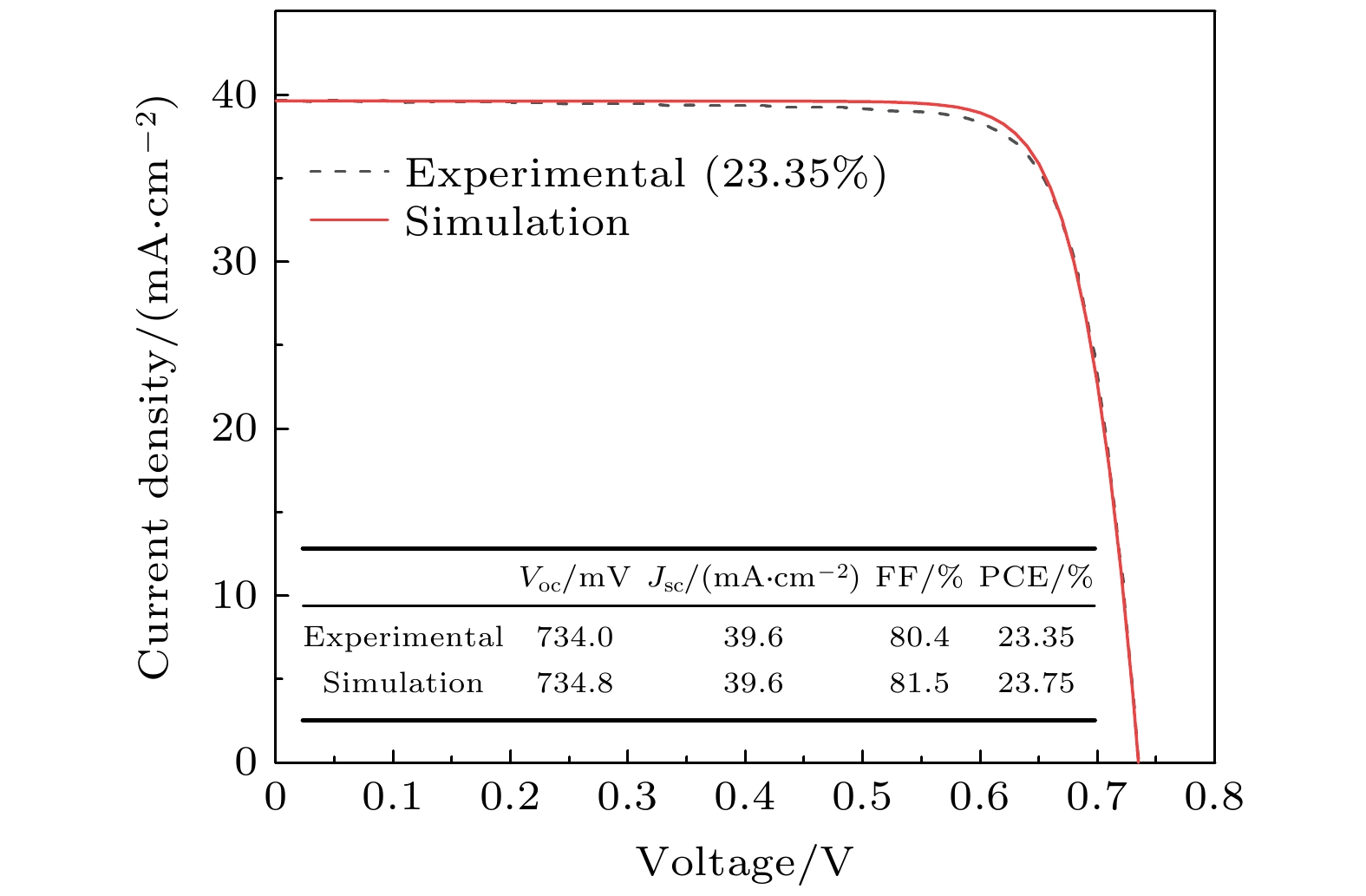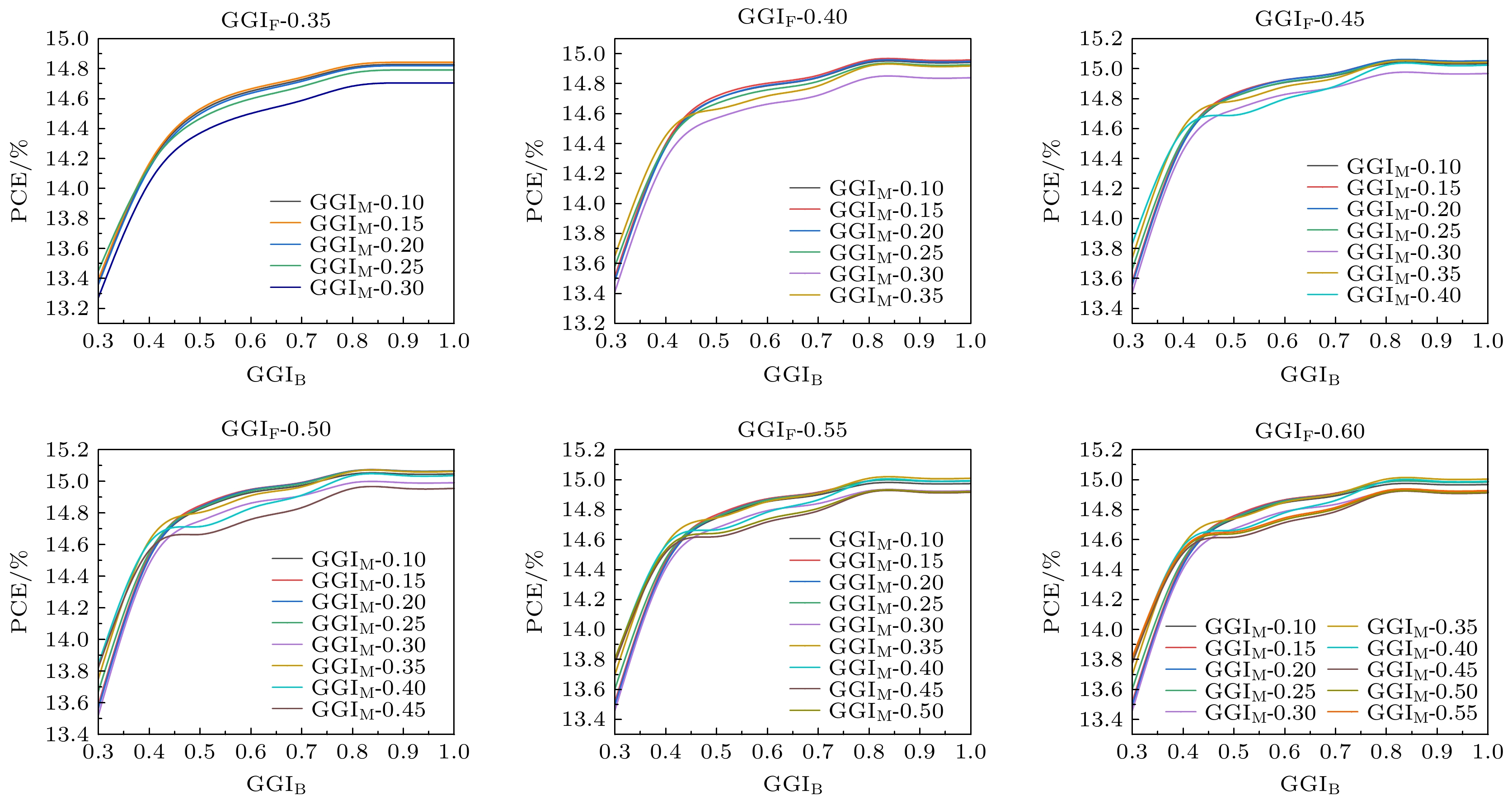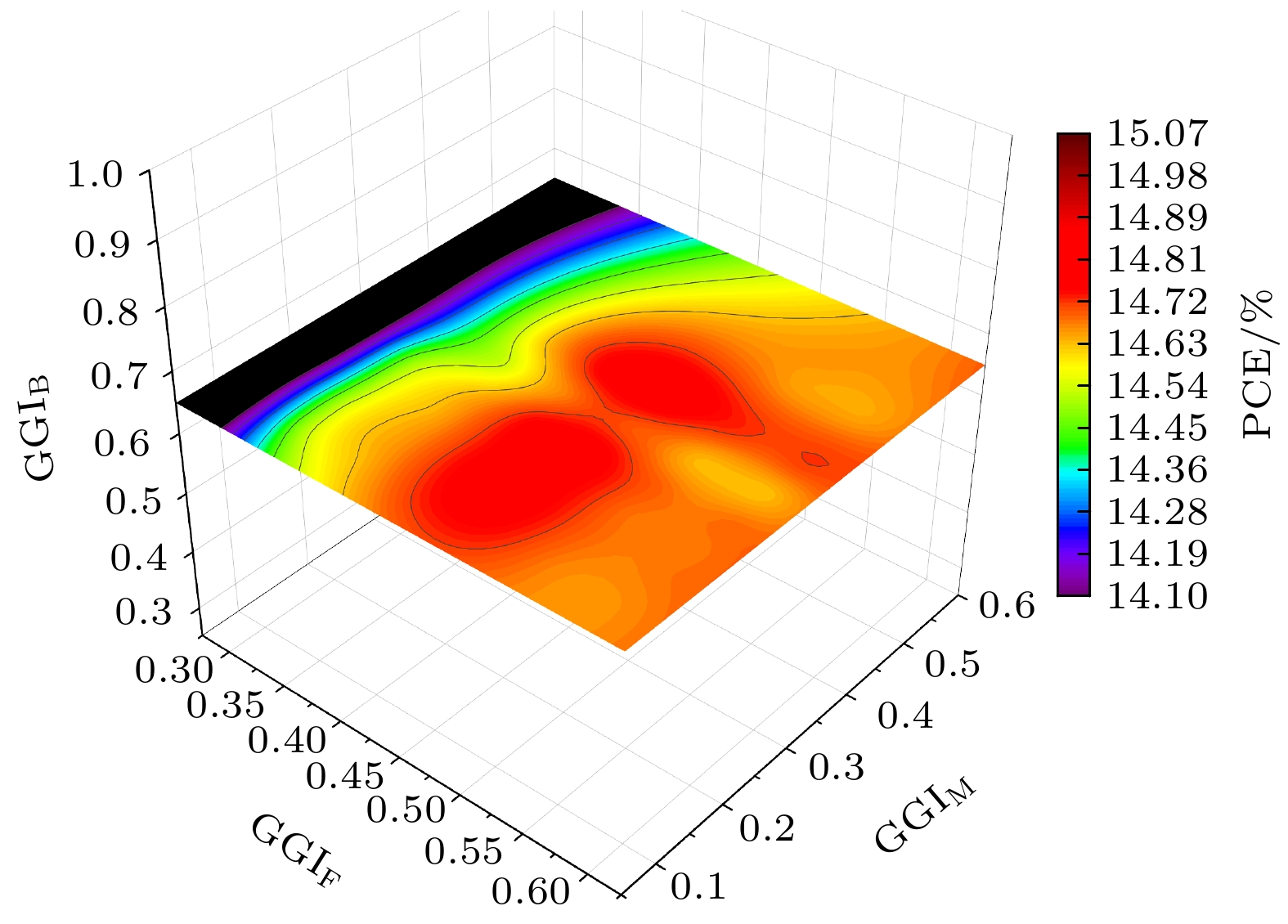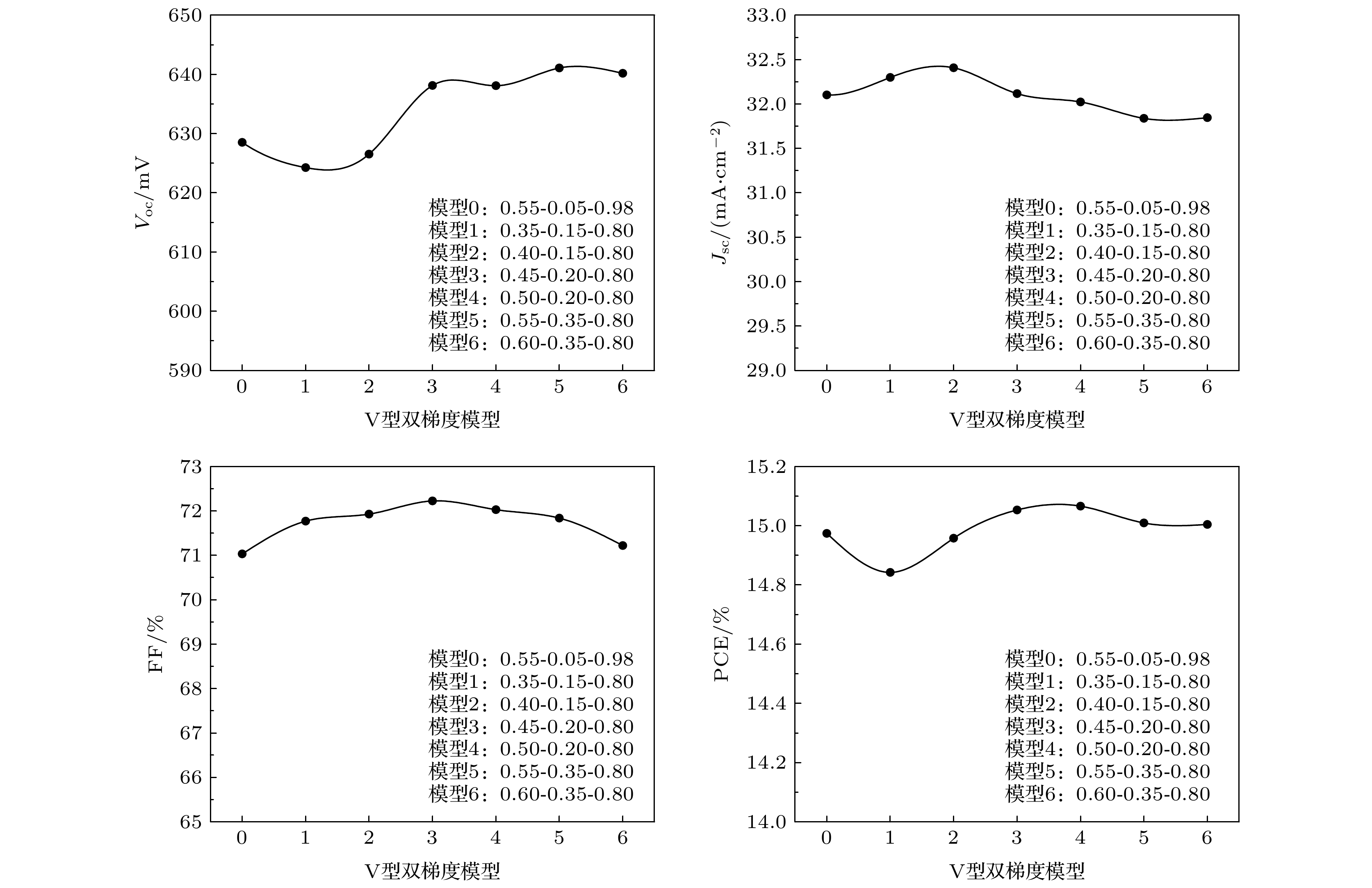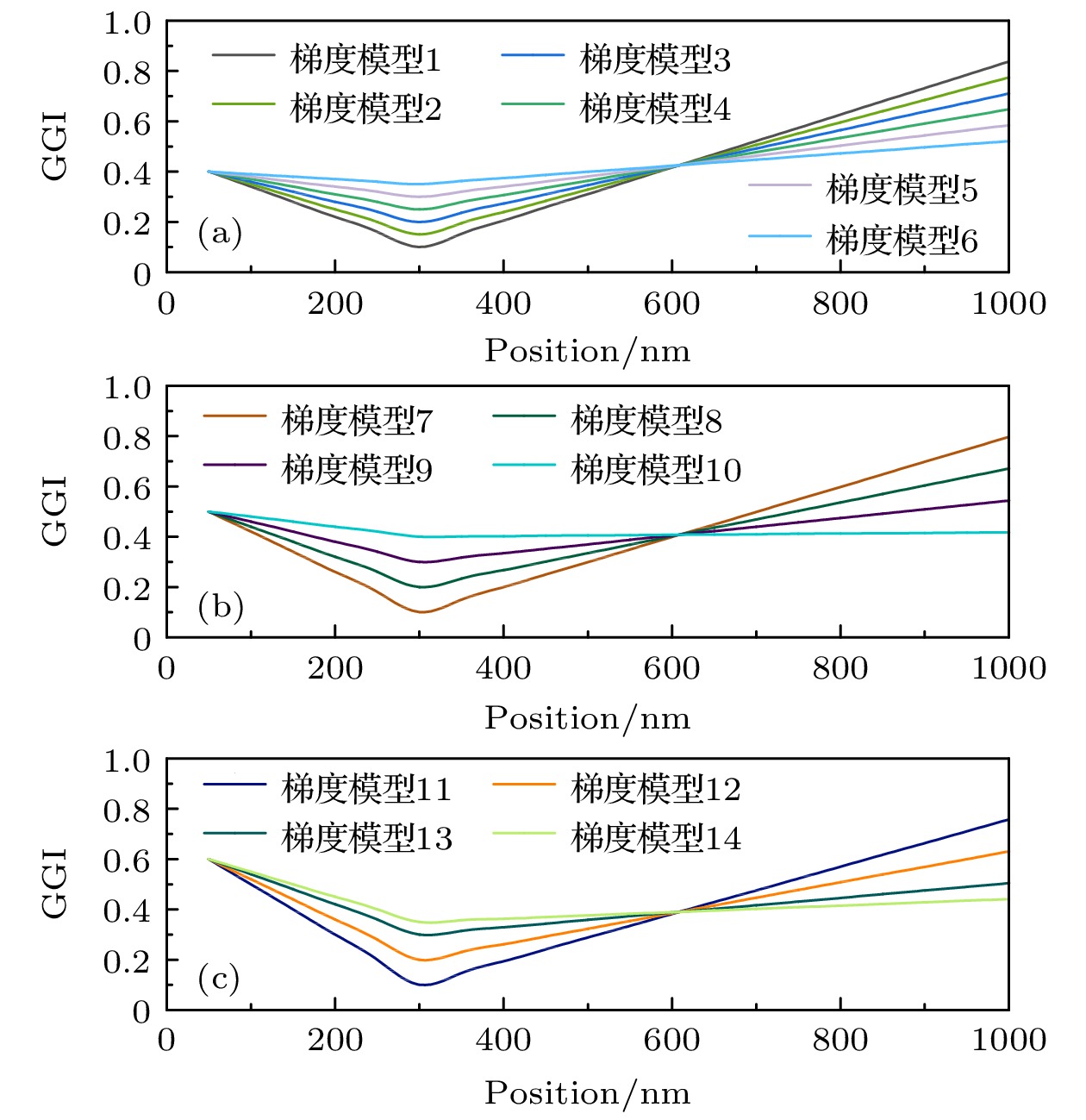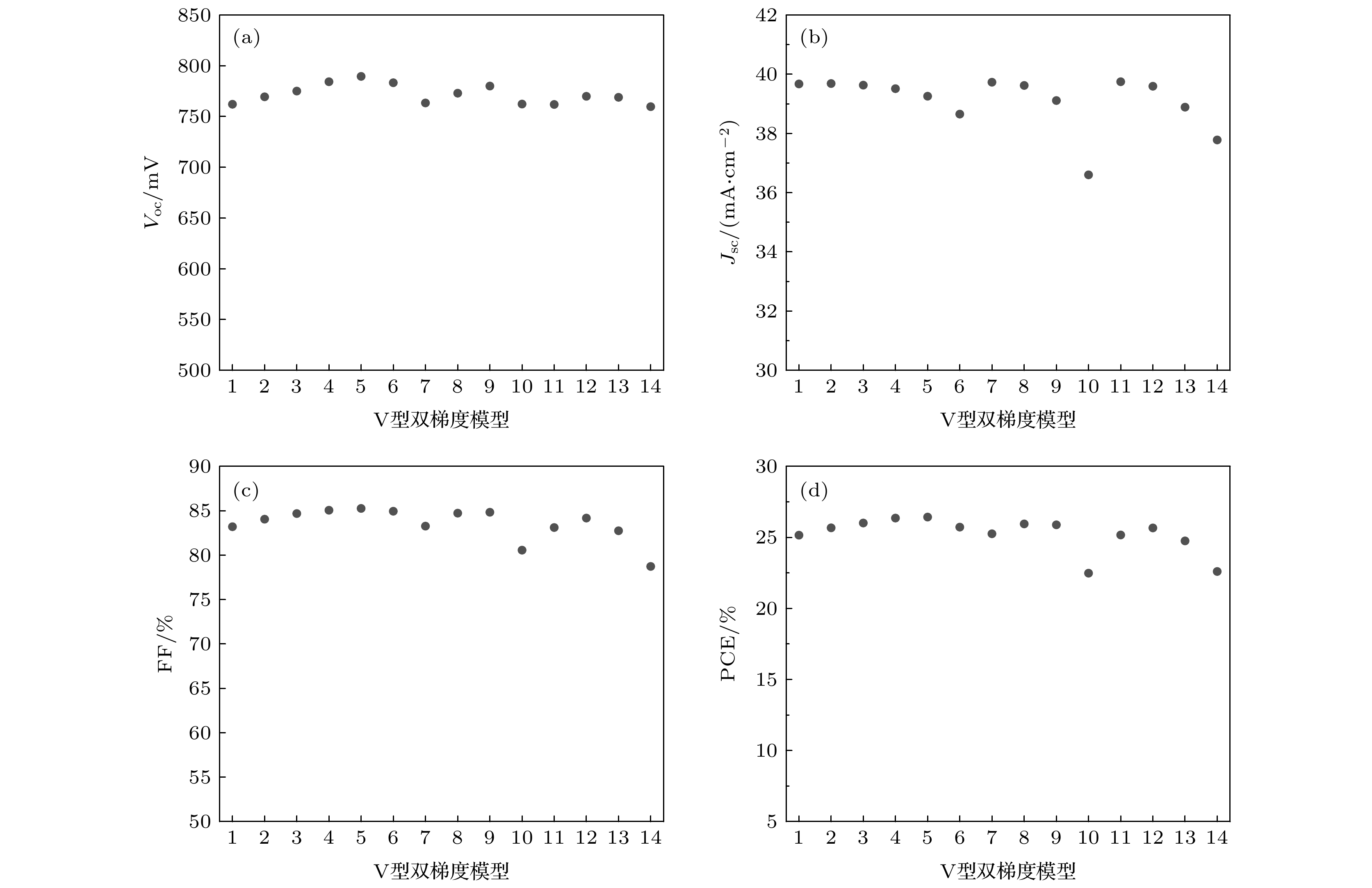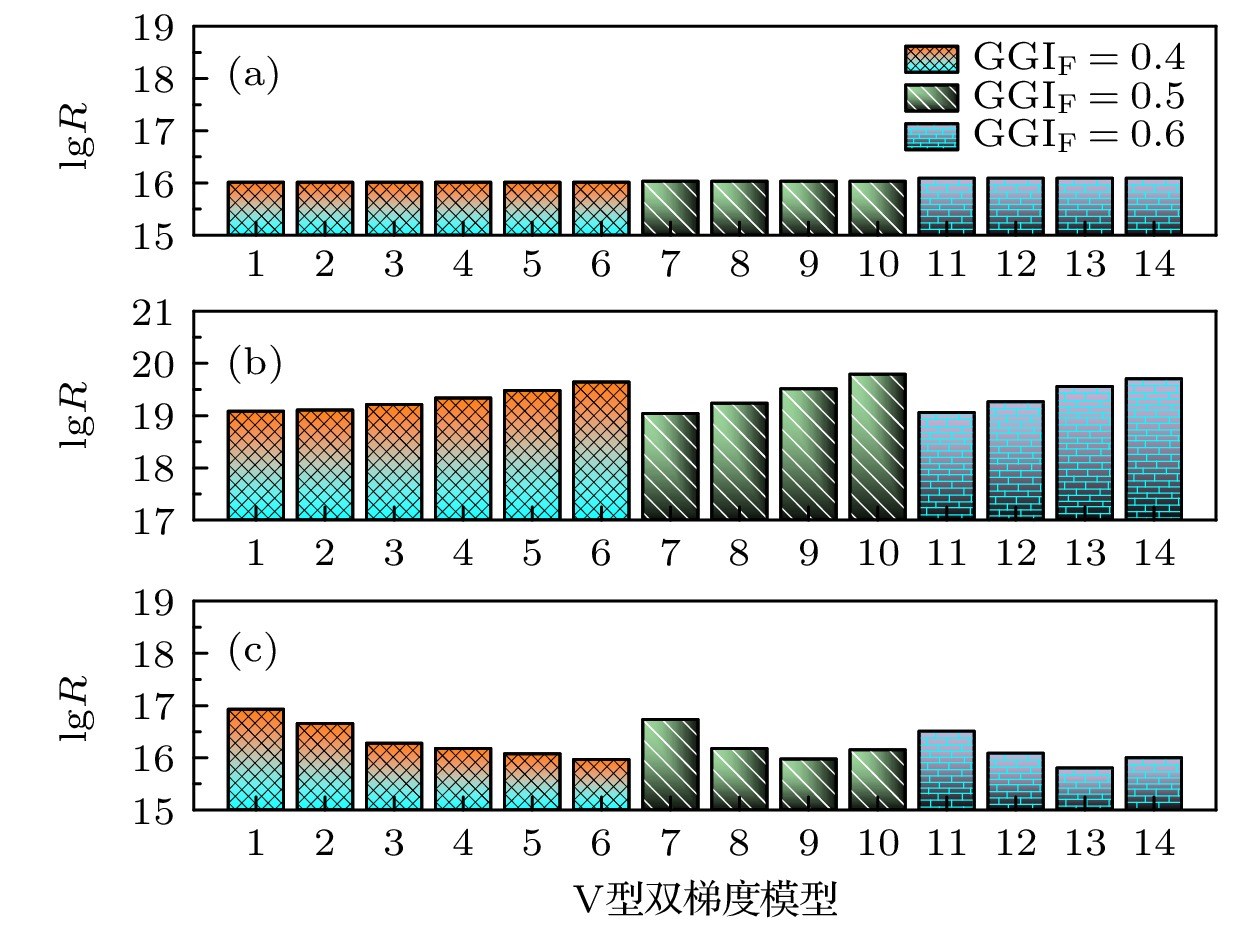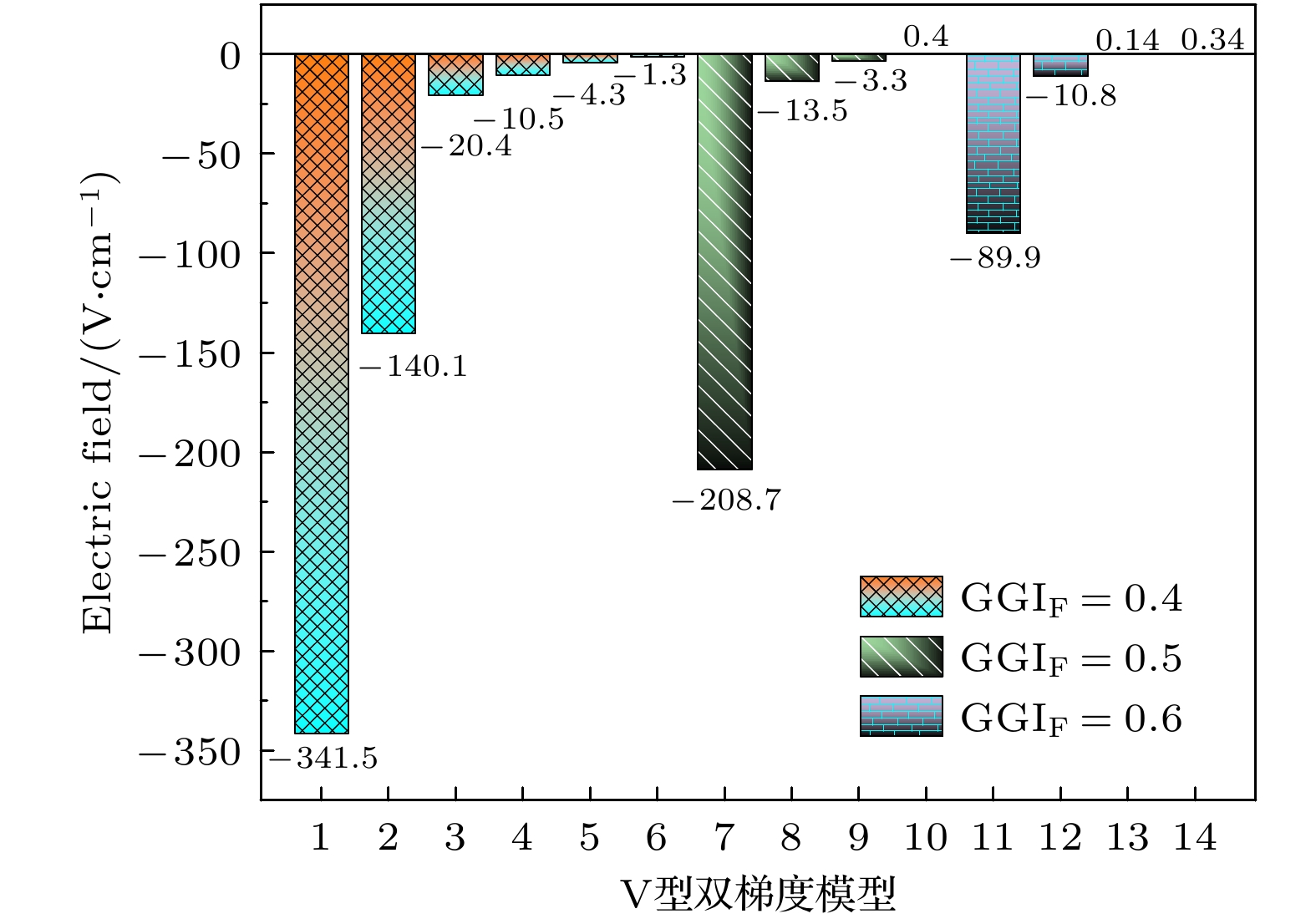-
Cu(In,Ga)Se2 (CIGS) solar cell is a kind of highly efficient thin film solar cell, for which Ga ratio (Ga/(Ga+In), GGI) gradient engineering is an efficient approach to achieving high open circuit voltage under no short circuit current loss. In this work, we firstly evaluate the room and the strategies for improving the device performance of the CIGS solar cells based on the comparison among their theoretical efficiency limits. Then we investigate the different schemes of “V” type GGI gradient and their effects on device performance through machine learning and device simulation. Based on these studies, we optimize the scheme of “V” type GGI gradient and obtain a high efficiency of 26% from device simulation. The carrier kinetics for the effect of modifying GGI gradient on device performance are analyzed. This work provides an approach to optimizing the GGI gradient to obtain highly efficient CIGS solar cells, which is referable for experimental optimization.
-
Keywords:
- Cu(In,Ga)Se2 solar cells /
- Ga gradient /
- efficiency limit /
- machine learning /
- device simulation
[1] Nakamura M, Yamaguchi K, Kimoto Y, Yasaki Y, Kato T, Sugimoto H 2019 IEEE J. Photovoltaics 9 1863
 Google Scholar
Google Scholar
[2] Belghachi A, Limam N 2017 Chin. J. Phys. 55 1127
 Google Scholar
Google Scholar
[3] Peace B, Claypoole J, Sun N, Dwyer D, Eisaman M D, Haldar P, Efstathiadis H 2016 J. Alloys Compd. 657 873
 Google Scholar
Google Scholar
[4] Lim D, Kim M Y, Song W 2016 Sci. Adv. Mater. 8 558
 Google Scholar
Google Scholar
[5] Jackson P, Hariskos D, Wuerz R, et al. 2015 Phys. Status Solidi RRL 9 28
 Google Scholar
Google Scholar
[6] Aissani H, Helmaoui A, Moughli H 2017 Int. J. Appl. Eng. Res. 12 227
[7] Saadat M, Moradi M, Zahedifar M 2016 Superlattices. Microstruct. 92 303
 Google Scholar
Google Scholar
[8] Majeed N, Saladina M, Krompiec M, Greedy S, Deibel C, MacKenzie R C I 2020 Adv. Funct. Mater. 30 1907259
 Google Scholar
Google Scholar
[9] Buratti Y, Le Gia Q T, Dick J, Zhu Y, Hameiri Z 2020 NPJ Comput. Mater. 6 1
 Google Scholar
Google Scholar
[10] Zhu C W, Liu W, Li Y Y, et al. 2021 Sol. Energy 228 45
[11] Kato T, Wu J L, Hirai Y, Sugimoto H, Bermudez V 2018 IEEE J. Photovoltaics 9 325
[12] Jackson P, Wuerz R, Hariskos D, Lotter E, Witte W, Powalla M 2016 Phys. Status Solidi RRL 10 583
 Google Scholar
Google Scholar
[13] Tai K F, Kamada R, Yagioka T, Kato T, Sugimoto H 2017 Jpn. J. Appl. Phys. 56 08MC03
 Google Scholar
Google Scholar
[14] Green M, Dunlop E, Hohl-Ebinger J, Yoshita M, Kopidakis N, Hao X 2021 Prog. Photovoltaics Res. Appl. 29 3
 Google Scholar
Google Scholar
[15] Yoshikawa K, Kawasaki H, Yoshida W, Irie T, Konishi K, Nakano K, Uto T, Adachi D, Kanematsu M, Uzu H, Yamamoto K 2017 Nat. Energy 2 1
[16] Haase F, Hollemann C, Schäfer S, Merkle A, Rienäcker M, Krügener J, Brendel R, Peibst R 2018 Sol. Energy Mater. Sol. Cells 186 184
 Google Scholar
Google Scholar
[17] Yoo J J, Seo G, Chua M R, Park T G, Lu Y, Rotermund F, Kim Y K, Moon C S, Jeon N J, Correa-Baena J P, Bulović V, Shin S S, Bawendi M G, Seo J 2021 Nature 590 587
 Google Scholar
Google Scholar
[18] Jeong M, Choi I W, Go E M, Cho Y, Kim M, Lee B, Jeong S, Jo Y, Choi H W, Lee J, Bae J H, Kwak S K, Kim D S, Yang C 2020 Science 369 1615
 Google Scholar
Google Scholar
[19] Green M A, Dunlop E D, Levi D H, Hohl-Ebinger J, Yoshita M, Ho-Baillie A W Y 2019 Prog. Photovoltaics Res. Appl. 27 565
 Google Scholar
Google Scholar
[20] Green M A, Hishikawa Y, Dunlop E D, Levi D H, Hohl-Ebinger J, Yoshita M, Ho-Baillie A W Y 2019 Prog. Photovoltaics Res. Appl. 27 3
 Google Scholar
Google Scholar
[21] Polman A, Knight M, Garnett E C, Ehrler B, Sinke W C 2016 Science 352 aad4424
 Google Scholar
Google Scholar
[22] Nayak P K, Cahen D 2014 Adv. Mater. 26 1622
 Google Scholar
Google Scholar
[23] Jackson P, Hariskos D, Lotter E, Paetel S, Wuerz R, Menner R, Wischmann W, Powalla M 2011 Prog. Photovoltaics Res. Appl. 19 894
 Google Scholar
Google Scholar
[24] Liu Y, Li B, Lin S, Liu W, Adam J, Madsen M, Rubahn H G, Sun Y 2018 J. Phys. Chem. Solids 120 190
 Google Scholar
Google Scholar
[25] Saadat M, Moradi M, Zahedifar M 2016 J. Mater. Sci. -Mater. Electron. 27 1130
 Google Scholar
Google Scholar
[26] Ji S, Hayakawa T, Suyama N, Nakada K, Yamada A 2020 Jpn. J. Appl. Phys. 59 041003
 Google Scholar
Google Scholar
[27] 刘芳芳, 孙云, 何青 2014 物理学报 63 047201
 Google Scholar
Google Scholar
Liu F F, Sun Y, He Q 2014 Acta Phys. Sin. 63 047201
 Google Scholar
Google Scholar
-
图 6 RF算法预测的不同GGI梯度的器件性能. 其中, 0代表实验效率为23.35%的电池所采用的GGI梯度, 模型1—模型6为预测效率最高的6组器件的GGI梯度
Figure 6. Predicted device performance of the CIGS solar cells based on different GGI gradients by RF algorithm. 0 represents for the GGI gradient used in the device with 23.35% experimental efficiency, while 1–6 are the GGI gradients of the devices with the highest predicted efficiency.
表 1 CIGS, c-Si, 钙钛矿三种电池的光伏特性参数、S-Q极限值及差值分析. Eg, PCE/VOC/JSC/FF, JSQ, WOC分别代表材料的带隙、电池的转换效率/开路电压/短路电流密度/填充因子、SQ极限计算的短路电流密度、VOC损失
Table 1. Photovoltaic parameters, S-Q limit value and difference analysis of CIGS, c-Si, and perovskite solar cells. Here, Eg, PCE/VOC/JSC/FF, JSQ, WOC respectively represent the band gap of the absorption material, the photoelectric conversion efficiency/open circuit voltage/short-circuit current density/fill factor of the solar cells, the short-circuit current density calculated by the SQ limit, and the VOC loss.
Cell type Eth/eV PCE/% VOC/mV JSC/(mA·cm–2) FF/% JSQ/(mA·cm–2) WOC/mV JSC/JSQ/% 机构 参考文献 CIGS 1.088 23.35 734.0 39.58 80.4 44.0 354.0 89.95 SF [1] CIGS 1.130 22.92 746.0 38.50 79.7 43.0 384.0 89.53 SF [11] CIGS 1.143 22.60 741.0 37.80 80.6 42.3 402.0 89.36 ZSW [12] CIGS 1.110 22.30 722.0 39.40 78.2 43.7 388.0 90.16 SF [13] c-Si 1.120 26.70 738.0 42.65 84.9 43.3 382.0 98.50 Kaneka [14] c-Si 1.120 26.60 740.3 42.50 84.7 43.3 379.7 98.15 Kaneka [14] c-Si 1.120 26.30 744.0 42.30 83.8 43.3 376.0 97.69 Kaneka [15] c-Si 1.120 26.10 726.6 42.62 84.3 43.3 393.4 98.43 ISFH [16] 钙钛矿 1.550 25.20 1180.5 25.14 84.8 27.1 369.5 92.77 KRICT [17] 钙钛矿 1.480 24.64 1181.4 26.18 79.6 29.5 298.6 83.53 UNIST [18] 钙钛矿 1.574 24.20 1194.8 24.16 84.0 26.2 379.2 92.21 KRICT [19] 钙钛矿 1.536 23.70 1169.7 25.40 79.8 27.6 366.3 92.03 ISCAS [20] 表 2 器件模拟中使用的参数设置
Table 2. Parameter settings used in device simulation.
B:ZnO Zn(Mg, O) Zn(O, S, OH)x CIGS Thickness/nm 500 50 8 1000 Permittivity/1 9 10 9 13.6 Eg/eV 3.3 3.6 3.6 1.06—1.66 Affinity/eV 4.4 4.2 4.2 3.89—4.49 Nc/(1018 cm–3) 2.2 2.2 2.2 2.2 Nv/(1019 cm–3) 1.8 1.8 1.8 1.8 µn/(cm2·V–1·s–1) 100 100 100 100 µp/(cm2·V–1·s–1) 25 25 25 25 Nd/(1017 cm–3) 10 10 1 0 Na/(1016 cm–3) 0 0 0 2 表 3 不同位置GGI与光伏参数之间的相关性
Table 3. Correlation between GGI value at different location and photovoltaic parameters.
GGIF GGIM GGIB VOC 0.38 0.35 0.34 JSC –0.26 –0.41 –0.12 表 4 wxAMPS器件模拟所用的GGI梯度模型
Table 4. Schemes of GGI gradient used for wxAMPS device simulation.
模型 1 2 3 4 5 6 7 GGIF 0.40 0.40 0.40 0.40 0.40 0.40 0.50 GGIM 0.10 0.15 0.20 0.25 0.30 0.35 0.10 GGIB 0.84 0.77 0.71 0.65 0.58 0.52 0.80 模型 8 9 10 11 12 13 14 GGIF 0.50 0.50 0.50 0.60 0.60 0.60 0.60 GGIM 0.20 0.30 0.40 0.10 0.20 0.30 0.40 GGIB 0.67 0.54 0.42 0.76 0.63 0.50 0.44 -
[1] Nakamura M, Yamaguchi K, Kimoto Y, Yasaki Y, Kato T, Sugimoto H 2019 IEEE J. Photovoltaics 9 1863
 Google Scholar
Google Scholar
[2] Belghachi A, Limam N 2017 Chin. J. Phys. 55 1127
 Google Scholar
Google Scholar
[3] Peace B, Claypoole J, Sun N, Dwyer D, Eisaman M D, Haldar P, Efstathiadis H 2016 J. Alloys Compd. 657 873
 Google Scholar
Google Scholar
[4] Lim D, Kim M Y, Song W 2016 Sci. Adv. Mater. 8 558
 Google Scholar
Google Scholar
[5] Jackson P, Hariskos D, Wuerz R, et al. 2015 Phys. Status Solidi RRL 9 28
 Google Scholar
Google Scholar
[6] Aissani H, Helmaoui A, Moughli H 2017 Int. J. Appl. Eng. Res. 12 227
[7] Saadat M, Moradi M, Zahedifar M 2016 Superlattices. Microstruct. 92 303
 Google Scholar
Google Scholar
[8] Majeed N, Saladina M, Krompiec M, Greedy S, Deibel C, MacKenzie R C I 2020 Adv. Funct. Mater. 30 1907259
 Google Scholar
Google Scholar
[9] Buratti Y, Le Gia Q T, Dick J, Zhu Y, Hameiri Z 2020 NPJ Comput. Mater. 6 1
 Google Scholar
Google Scholar
[10] Zhu C W, Liu W, Li Y Y, et al. 2021 Sol. Energy 228 45
[11] Kato T, Wu J L, Hirai Y, Sugimoto H, Bermudez V 2018 IEEE J. Photovoltaics 9 325
[12] Jackson P, Wuerz R, Hariskos D, Lotter E, Witte W, Powalla M 2016 Phys. Status Solidi RRL 10 583
 Google Scholar
Google Scholar
[13] Tai K F, Kamada R, Yagioka T, Kato T, Sugimoto H 2017 Jpn. J. Appl. Phys. 56 08MC03
 Google Scholar
Google Scholar
[14] Green M, Dunlop E, Hohl-Ebinger J, Yoshita M, Kopidakis N, Hao X 2021 Prog. Photovoltaics Res. Appl. 29 3
 Google Scholar
Google Scholar
[15] Yoshikawa K, Kawasaki H, Yoshida W, Irie T, Konishi K, Nakano K, Uto T, Adachi D, Kanematsu M, Uzu H, Yamamoto K 2017 Nat. Energy 2 1
[16] Haase F, Hollemann C, Schäfer S, Merkle A, Rienäcker M, Krügener J, Brendel R, Peibst R 2018 Sol. Energy Mater. Sol. Cells 186 184
 Google Scholar
Google Scholar
[17] Yoo J J, Seo G, Chua M R, Park T G, Lu Y, Rotermund F, Kim Y K, Moon C S, Jeon N J, Correa-Baena J P, Bulović V, Shin S S, Bawendi M G, Seo J 2021 Nature 590 587
 Google Scholar
Google Scholar
[18] Jeong M, Choi I W, Go E M, Cho Y, Kim M, Lee B, Jeong S, Jo Y, Choi H W, Lee J, Bae J H, Kwak S K, Kim D S, Yang C 2020 Science 369 1615
 Google Scholar
Google Scholar
[19] Green M A, Dunlop E D, Levi D H, Hohl-Ebinger J, Yoshita M, Ho-Baillie A W Y 2019 Prog. Photovoltaics Res. Appl. 27 565
 Google Scholar
Google Scholar
[20] Green M A, Hishikawa Y, Dunlop E D, Levi D H, Hohl-Ebinger J, Yoshita M, Ho-Baillie A W Y 2019 Prog. Photovoltaics Res. Appl. 27 3
 Google Scholar
Google Scholar
[21] Polman A, Knight M, Garnett E C, Ehrler B, Sinke W C 2016 Science 352 aad4424
 Google Scholar
Google Scholar
[22] Nayak P K, Cahen D 2014 Adv. Mater. 26 1622
 Google Scholar
Google Scholar
[23] Jackson P, Hariskos D, Lotter E, Paetel S, Wuerz R, Menner R, Wischmann W, Powalla M 2011 Prog. Photovoltaics Res. Appl. 19 894
 Google Scholar
Google Scholar
[24] Liu Y, Li B, Lin S, Liu W, Adam J, Madsen M, Rubahn H G, Sun Y 2018 J. Phys. Chem. Solids 120 190
 Google Scholar
Google Scholar
[25] Saadat M, Moradi M, Zahedifar M 2016 J. Mater. Sci. -Mater. Electron. 27 1130
 Google Scholar
Google Scholar
[26] Ji S, Hayakawa T, Suyama N, Nakada K, Yamada A 2020 Jpn. J. Appl. Phys. 59 041003
 Google Scholar
Google Scholar
[27] 刘芳芳, 孙云, 何青 2014 物理学报 63 047201
 Google Scholar
Google Scholar
Liu F F, Sun Y, He Q 2014 Acta Phys. Sin. 63 047201
 Google Scholar
Google Scholar
Catalog
Metrics
- Abstract views: 3684
- PDF Downloads: 80
- Cited By: 0















 DownLoad:
DownLoad:
